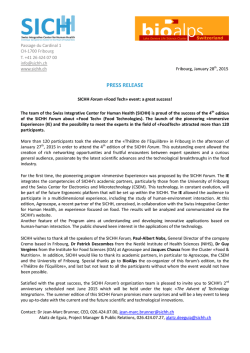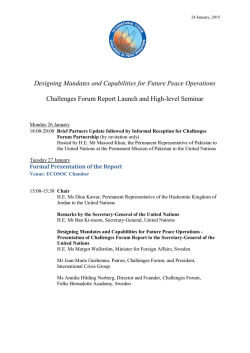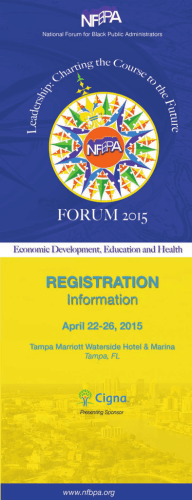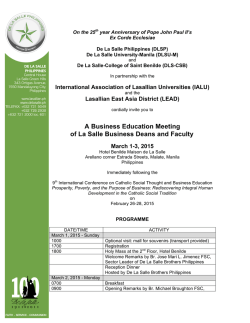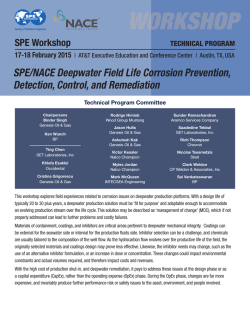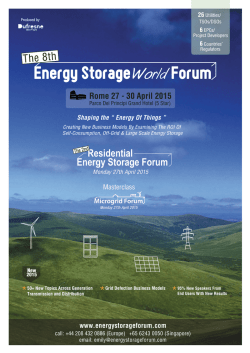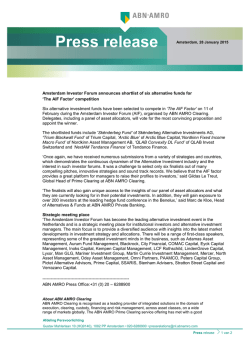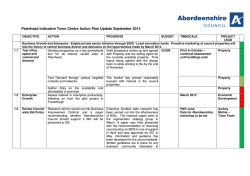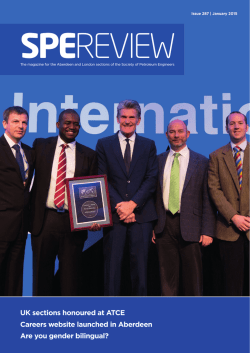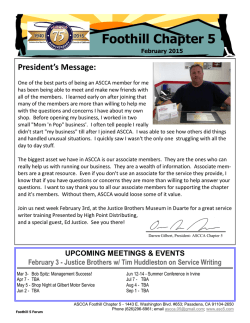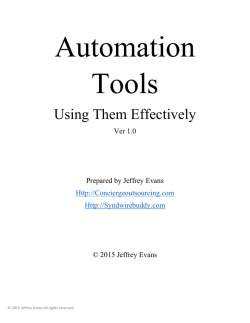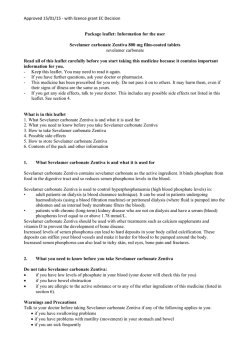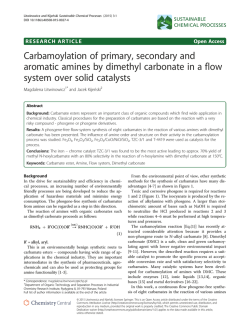
Forum Brochure - Society of Petroleum Engineers
More Than Thirty Years of Innovative Thought and Accelerated Results 23–26 February 2015 Le Meridien Istanbul Etiler, Istanbul, Turkey How Can We Double Chairpersons: Ali Yousef Saudi Aramco Stephen Dyer Schlumberger Committee: Ali Issa A. Abdelkerim ZADCO Bruno Lalanne Total Eric Delamaide IFP Technologies Fred Arasteh Weatherford George J. Hirasaki Rice University Guan Qin University of Houston Hamid Behzadi Oxy Kassem Ghorayeb Schlumberger Carbonate Reservoir Recovery? Application Deadline: 29 January 2015 More than 62% of the world’s oil and 40% of the gas reserves reside in carbonates, with recovery factors that are significantly lower than in sandstones. With a global average recovery rate of 30% today, can we make a 60% or higher recovery a reality for carbonate oil fields in the future? This SPE forum will address new and emerging science and technology such as reservoir characterisation, nano and bio-technologies, material and computational science, and physics and chemistry that could provide significant gains. It will focus on the future needs and opportunities. As oil recovery processes involve the interplay of rock/fluids and thermodynamic interactions, the optimisation of hydrocarbon production requires a clear understanding of both static and dynamic reservoir properties at different scales, ranging from pore to meso-scale. Variability of the connected pore space or “flow channels” throughout the reservoirs tends to dominate fluid sweep. Vugs, fractures, micro-porosity, and karsts all play a significant role. Variable wettability within carbonate systems can also differ significantly from sandstones that tend to be strongly water-wet, affecting the relative mobility of the displacing fluids. By addressing some of the fundamental understandings at the outset, the forum will address the needed and emerging technologies to improve reservoir properties and their impact on fluid sweep at different levels. The forum also addresses data upscaling from the laboratory to the field. Taking this understanding beyond the range of the wellbore is crucial in managing field production strategies. The use and improvement of secondary and enhanced oil recovery techniques such as chemical and/or biological will be covered by linking back to the fundamentals. What is needed for deeper understanding of mechanism and control of wettability alteration towards minimal residual oil? Can thermal recovery processes or solvents work effectively? How can new well geometries (e.g. MRC, ERC wells) be optimised? Reservoir monitoring also plays a key role to get a clear understanding of the recovery efficiency. As less gas becomes available for secondary recovery, can we utilise other gases like N2₂or CO2₂or make polymers really work? What would be the optimum measurement set that would allow a comparison with field development and experimental results? And how about the scale-up issues; can these be short circuited somehow? As we understand and monitor flooding, what control mechanisms are available for us to optimise production, and what are the “gotcha’s” in the production stream from an assurance and surveillance standpoint. Finally the technology possibilities of the future will be discussed with a view to providing some of the key road map requirements for doubling carbonate recovery. Linhua Guan Statoil Who Will the Forum Appeal to? Matthew Jackson Imperial College London This forum will appeal to multidisciplinary teams and technical experts in operating companies, service companies, and academic institutions who are involved in aspects of field planning, reservoir gesociences, reservoir, and production engineering. Raj Tewari Petronas Roman Berenblyum International Research Institute of Stavanger Shaikhan Al Khadhuri Petroleum Development Oman Forum Series Liaison: What is a Forum? SPE Forums offer an exclusive opportunity to interact with innovators, foremost professionals, and leading technologists. The objective is to create a collaborative, idea-generating forum that stimulates new ideas and innovation about future challenges facing the E&P industry. Participants at SPE Forums are selected by the Forum Steering Committee based on their ability to contribute to facilitated discussions of the topic. Participants are encouraged to come prepared to contribute their experience and knowledge, rather than be spectators or students. If you have a role to play in meeting the challenges of tomorrow head-on, apply today. Ashraf Tahini Saudi Aramco Benefits To You and Your Organisation Birol Demiral Schlumberger • Gain insight and perspective through conversations with peers who share your same interests. • Enjoy the relaxed atmosphere of learning through one-on-one interaction. • eet with other experts from international companies, research institutes, and universities in M an off-the-record format. • Form professional relationships that will continue after the forum has ended. www.spe.org/events/14fme1 23–26 February 2015 Istanbul, Turkey How Can We Double Carbonate Reservoir Recovery? These exciting topics will be discussed in an open setting designed for optimal input from all participants. Monday, 23 February 2015 0900–1230 hours Session I: Back to Fundamentals—Physics and Chemistry of Carbonate Petroleum Systems Session Managers: Matthew Jackson, Imperial College London; Roman Berenblyum, International Research Institute of Stavanger As an industry and arguably in academia also, we tend to get attracted to the “next big thing” and search for how we can apply this knowledge to various applications. Nanotechnology, artificial intelligence, deep-imaging, intelligent field—all are terms we have become accustomed to. However the fundamental questions remain largely unanswered—It is physics and chemistry at the molecular level between the rock surface, the various components within the oil and water fluid phases that control the processes and need to be fully understood. What drives the conditions of wettability, interfacial, or capillary forces, adhesion, and relative permeability? Could those conditions be changed? What are the mechanisms? Colloidal science, molecular chemistry, and geo-chemistry, all play a huge role in understanding this over time scales that necessarily have to cross from the geological to that of the displacing fluids within a primary, secondary, or tertiary recovery scenario. Monday, 23 February 2015 1400–1730 hours Session II: Understanding the Remaining Oil at the Reservoir Scale—How Far Can Technology Take Us? Session Managers: Ali Issa A. Abdelkerim, ZADCO; Raj Tewari, Petronas Reservoir characterisation tools have been around since the early 1900s. Yet we still can only see the first few inches to maximum feet away from the wellbore. Is this sufficient to determine the quantity and the location of the remaining oil in place? Well construction technologies have allowed vast improvements in accessing reserves. But at what level is the current limit on well spacing in carbonate fields appropriate for correlating fluid saturation across a field? What breakthroughs or innovations in existing technology are needed that might help resolve the location, quantity, and interfacial status of the remaining oil in place to the resolution required to know what to do about it? Tuesday, 24 February 2015 0900–1230 hours Session III: So We Think We Know How and Where the Fluids Are Held in Place, So Now What Can We Do About It? Session Managers: Ali Yousef, Saudi Aramco; George J. Hirasaki, Rice University If we knew the condition of the fluids residing in the pore space and how they were locked in place, how could we impact these? Chemistry at the fundamental level must play a huge part here. At the pore level it is about getting these “agents of recovery” to act at the right place and right time, and preferably coming back with the crude to re-cycle. What are the molecules that might offer a step change in recovery fundamentals for the future, and how do they address the physicchemistry discussed earlier? How do we assure ourselves they will do the right thing in situ in field conditions, and how could we demonstrate this? What are the processes in the pipeline? (1) Low salinity or altered electrolyte waterflooding (2) Thermal recovery in stylolite formations (3) Acid gas (CO2 and/or H2S) miscible displacement (4) Surfactants for low IFT (5) Foam mobility control. Tuesday, 24 February 2015 1400 hours onwards Group tour followed by dinner www.spe.org/events/14fme1 Wednesday, 25 February 2015 0900–1230 hours Session IV: Are We Delivering the Agents to the Right Spot? If Not How To Correct? Session Managers: Eric Delamaide, IFP Technologies; Fred Arasteh, Weatherford Identifying chemicals able to increase recovery in the lab at the core scale is only the first step in increasing recovery. The second step is being able to deliver those chemicals where they need to go. In fractured reservoirs, chemicals must be able to enter the matrix in a “reasonable” timeframe. This may not be possible if the rock is oil wet or the target area is too large. The existence of a fracture network can facilitate chemical delivery farther away from injectors but may bypass oil in the matrix surrounding the well. Conversely in non-fractured, low permeability carbonates, fluid mobility is very limited and may require high injection pressures. Another key challenge is how to determine whether the chemical or other agent has actually reached their target. It is quite possible to manage their diversion inside or proximal to the wellbore, but controlling them beyond remains a major challenge. Wednesday, 25 February 2015 1400–1730 hours Session V: So We Think We Are Applying the Optimal EOR Methods, How Do We Now Assess and Monitor Their Incremental Recovery? Session Managers: Fred Arasteh, Weatherford; Kassem Ghorayeb, Schlumberger Are the current available saturation measurement technologies sufficient to determine how well our EOR agents are performing? If not, then what else is needed? And where does the industry R&D stand in this regard? The producing streams will, at some point, be impacted by the improved reserves recovery, but what other issues should be brought to the table that have to be managed, and how should we manage them (e.g. environmental issues)? The statement “how do we double carbonate reservoir recovery” should drive the question—Do we actually know when we have recovered double the original estimates? Are there novel ways we could measure or “tag” each barrel of additional oil produced due to the improved recovery method employed. Thursday, 26 February 2015 0900–1230 hours Assurance and Session VI: Production Session VI: Surveillance—What Are The Challenges We Should Be Conscious Of And How Should We Address Them? Session Managers: Hamid Behzadi, Oxy; Stephen Dyer, Schlumberger Production assurance challenges tend to increase when adding agents to the injection scheme. How could these agents of the future affect our production systems, and the associated hardware required to move crude from the reservoir to the stock tank? What are the key challenges that need solving today to create the production (or injection) wells and pipeline facilities of the future? Surveillance is crucial in recovery optimisation especially in fractured reservoirs since the flood front breakthrough can be sudden and in unexpected locations. The question remains—How can we have comprehensive and efficient surveillance while providing the level of control needed to positively impact recovery without becoming too extravagant? Thursday, 26 February 2015 1400–1730 hours Session VII: Enhancing Carbonate Fields Recovery Through New And Emerging Technologies Session Managers: Bruno Lalanne, Total; Shaikhan Al Khadhuri, Petroleum Development Oman The oil industry has a long history in producing carbonate fields with many good practices and technologies that can be used as learning for other fields with similar characteristics and challenges. Still, numerous challenges remain. For example, the domains of tool resolutions, characterisation and upscaling of heterogeneity, tracking preferential flow paths and by-passed areas, optimisating well placement, to name a few. R&D innovations and advances in understanding the physic-chemical interactions at various scales should offer new perspectives in chemical, polymer and salt water injection, thermal, or biotechnologies. This session provides a platform to address new and emerging sciences and innovations in fields such as nano or bio-technologies, material, computational science, physics and chemistry that significantly impact the ways we characterise and manage our reservoirs, discussing, and focusing on future needs and opportunities. How Can We Double Carbonate Reservoir Recovery? 23–26 February 2015 Istanbul, Turkey Forum Guidelines • Participants are expected to attend every session. • Slides are limited, allowing maximum time for informal discussions and exchange of experience. • Conducted off the record to support the free interchange of information and ideas. • Extensive note taking is not allowed. • Recording of any forum session is prohibited. • Information disclosed at a forum may not be used publicly without the originator’s permission. • articipants are requested to omit reference to forum proceedings in any subsequent published work or P oral presentation. • A written summary may be prepared and distributed to attendees after the forum with unanimous attendee agreement and at the discretion of the steering committee and SPE approval. • No commercialism. Application Information APPLY TODAY! Participants at SPE Forums are selected by the Forum Steering Committee based on the ability to contribute to the discussion of the topic. Attendance is limited to maximise each person’s opportunity to contribute. Accepted applicants will receive their registration form and other materials within two weeks of the application deadline. For those requiring visas to attend the forum, please ensure that you leave sufficient time for your visa to be processed. Online:www.spe.org/events/14fme1 Mail: SPE Middle East, PO Box 215959, Dubai, UAE Fax:+971.4.457.3164 An electronic version of the printed application form is available for downloading and printing at www.spe.org/events/14fme1. You may also contact SPE at +971.4.457.5800 or [email protected] to receive a printed application form via mail, fax, or email. If the committee accepts your application, you will receive registration materials, including more detailed information on housing, transportation, and fees. If your application is placed on a waiting list, you will receive notification of that fact. After notification of acceptance, your registration form with payment must be returned by 23 January 2015 to ensure your place in the forum. Forum Registration Fee: E arly Bird: USD 2,800 (Before 23 January 2015) Late Fee: USD 3,100 (After 23 January 2015) Includes the following for the forum participant • • • • • • Registration to attend all seven forum sessions. Four nights of hotel accommodation including breakfast based on single occupancy. Welcome reception on Sunday, 22 February 2015. Group dinner on Monday, 23 February 2015 from 1800 hours. Group tour followed by dinner on Tuesday, 24 February 2015 starting from 1400 hours. Lunch provided on all four days. Please note: Attendees are expected to attend the full forum and the fee is a fixed full registration fee. The base registration fee does not include accompanying persons. Details of accommodation and rates for spouses and family members will be sent with the registration packet that will be emailed to each delegate upon acceptance. www.spe.org/events/14fme1
© Copyright 2025
